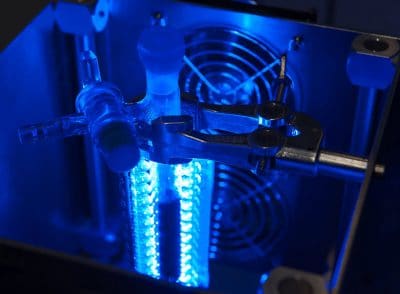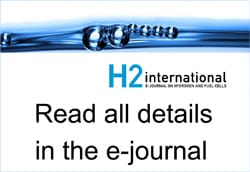Each day, the sun sends vast quantities of energy to the earth. During millions of years, our planet has adapted to this steady stream of power, developing clever ways to make efficient use of the solar resources it receives. Scientists have been trying to do the same in a rather minuscule amount of time. Over the past 20 years, they succeeded in using photocells to convert sunlight into electricity, a process marked by relatively high efficiency today. Not long ago, they began to redouble their efforts to capitalize on the potential that sunlight has for hydrogen production. It remains a challenge, though, to design both small systems, such as the ones described below, and large-scale installations, as depicted on page 46.
Helmholtz-Zentrum Berlin, a research institute based in Germany’s capital, is at the helm of a European research endeavor called PECSYS. The objective is to design an economically viable method for solar-powered hydrogen production in four years’ time. Achieving this objective will require an efficient combination of photocells and electrocatalysts to split water into its elements, hydrogen and oxygen.
There have been some breakthroughs in this field in recent years, but many questions have gone unanswered. For example, whereas photovoltaic systems have seen their share of advances, researchers have yet to figure out which technology will show the most promising results for water splitting. One of those crucial but unsolved issues is the choice of material for system construction.
What has been defined so far are the aims of the endeavor, supported with EUR 2.5 million from the EU’s Horizon 2020 program. Within four years, the project partners from Germany, Italy and Sweden are to develop the technology to a point at which several modules adding up to 10 square meters, or 108 square feet, can be set up for testing purposes. The subsequent testing period would be used to demonstrate that even large installations can provide the desired reliability and output.
…
PECSYS
The organization coordinating this EU venture is the Helmholtz-Zentrum Berlin’s center of excellence for photovoltaic technology. Other partners are the research center in Jülich, Germany; Uppsala University, Sweden; Consiglio Nazionale delle Ricerche, Italy; and two companies, the Swedish arm of Solibro Research, based in Germany, and Italian 3Sun. The project was launched in January 2017.
…



























See more about that rather old process, here:
http://www.hydrogenambassadors.com/background/direct-hydrogen-production-from-solar-energy.php